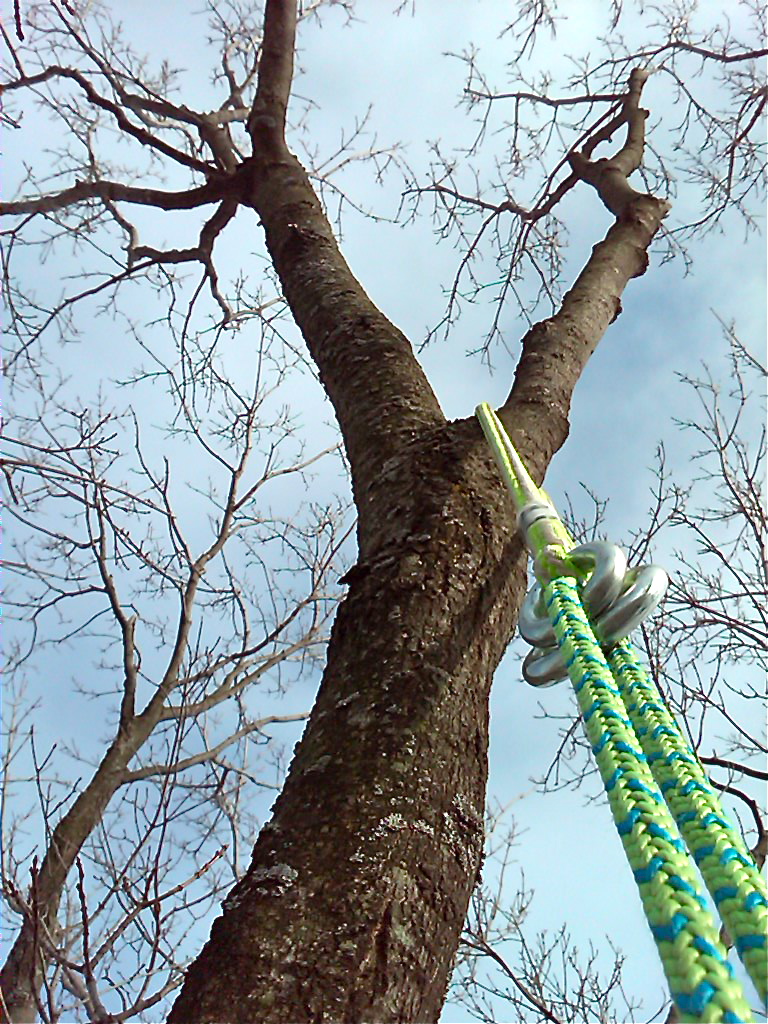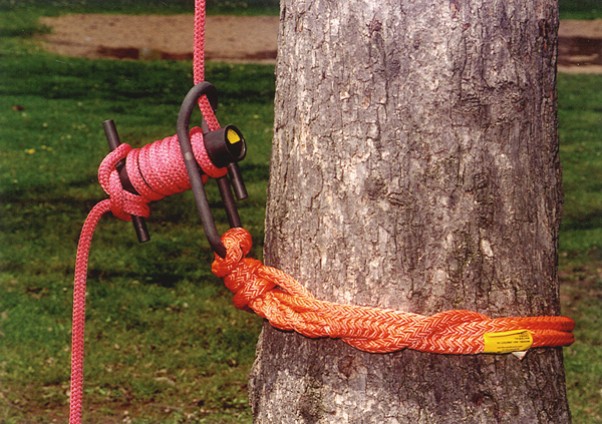Techniques


My style of climbing is pretty slick, I climb a double rope system, or DRT, which is basically 1 long climbing rope that goes up and over either a natural crotch in the tree, or through a friction saver of some type. Most of the time, if I can, I use a friction saver to save both the wear on the tree and my rope. Ropes are expensive and trees are alive.
I use a very thin running line or throwline to go over the desired TIP, or tie-in-point. After this is in place, I then either pull the friction saver up or over said limb, of if working off a natural crotch, I pull the climbing line directly over it by tying it to my throwline.
If the desired TIP is low enough and clear enough, I’ll hand throw the throwline over the limb. If it is too high or the approach is too tight, I’ll use the Big-Shot.
The Big-shot is basically a giant slingshot that you attach to 2- 4 foot fiberglass poles that snap together to make an 8 foot pole.
With this I can use my throw-bag (a small bag filled with steel shot, with a steel-tie ring on it) and the big-shot to fire the line over a crotch well in excess of 75 feet with great accuracy and power.
Once I have isolated the crotch and have the friction saver and climbing line in place, I can rig my hitchclimber climbing system up to enable me to move in and about the tree with great ease and safety. It is basically a cracking little multiple tie-in point pulley from DMM along with 2 oval karabiners from DMM called Ultra “O”s. This is all tied together with a 30" -32" eye and eye cord that I tie a friction hitch on.
A friction hitch is a knot tied onto the working, or "up" part of the climbing line.
This knot is then rigged through the hitchclimber pulley and one of the 2 karabiners , it is then attached by the bottom karabiner to the sliding ring on my climbing saddle. It is all very compact and with only one attachment point from system to person, it is very easy to keep and eye on while working.
With very little effort, I can pull down on the working end of my climbing line and advance up the tree. The hitchclimber system also allows me to manage slack very easily.
The friction hitch (either a Valdotain Tresse’ or a Distel) slides easily along the line while I’m moving, but as soon as I put tension on by letting go, it grips the line tight, keeping me securely aloft.
I can also climb on a single rope or "SRT" (single rope technique), this is the use of mechanical ascenders attached me and the rope which allow forward progress, but capture the rope to prevent sliding backwards.
SRT allows for a very fast ascent into the canopy, IE: a cat rescue where time is crucial.
I have recently employed the Singing Tree Rope Wrench™, this allows a climber to climb on a standard hitch, DdRT style; but while on a single line. ( actually, now 100% of my work is done on the faster, more efficient SRT system)
The advantages of climbing a single rope are many, less rope in the tree with you, ability to perform multiple redirects while retaining the same dependable friction. It allows me to climb on a 1:1 ratio, meaning that fro every foot of line I pull, I move a foot, unlike in DdRT, where you pull 2 feet of line to move 1 foot. this is just another tool that I have adopted in order to make me a more proficient climber, saving me time, and you, the client, money!
I also have the option of employing the Anchor Bridge Ropeworks "Secret Weapon" at any point during an SRT ascent to switch to DdRT ( doubled rope technique), this allows the use of both methods to effectively work on your trees without harmful spikes.
Once in the tree, I can use my silky handsaw to prune off any diseased, dead or dying limbs. Also, crisscrossed limbs and limbs over property and lines can be rigged and roped down.
We can rig, cut and lower huge wood with 1 ground person, both safely and efficiently. We do this with a combination of an arborist block or heavy-duty pulley that is built to withstand the stress of shock-loading or a sudden weight being absorbed by the pulley from a limb falling a bit before it is caught by the pulley and line.
Below is an example of SRT climbing by Andrew Joslin


On the ground at the base of the tree, is a simple device called a port-a-wrap. This slick unit is strapped to the base of the tree with an adjustable sling called a “whoopie sling”. The climber rigs a block in the tree with the aid of a dead-eye sling, and then the line is tied off to the limb to be removed.
The line or “bull-rope”, is then rigged through the port-a-wrap and a few wraps are taken around it to increase friction and control of the massive weight that is about to be dropped. When all is clear, I cut the limb and it is caught by the block and sling, and then lowered as soft as a baby’s butt to the ground by my ground-person with the aid of the port-a-wrap.
This is all done without the aid of a boom truck that is big, noisy and cumbersome to move around, not to mention the damage it can do to your yard, if it can even get IN your yard…
We can also do complete removals if necessary, for these, I sometimes climb with spurs or spikes, which normally will harm a tree.
Being that I am removing the tree, they are not an issue though in this case.
The same techniques that are used for pruning can be used in total removals, all safe, all low impact and eco-friendly.
After it is on the ground, my ground crew will make short work of cutting up the limbs and/or tree for disposal.
I strive for a very safe work routine, the safety of both you and your property, along with my ground crew and me; is always uppermost in my mind.
We are fast, we are efficient and we are safe.
Because I do not use boom truck, my overhead is very low, and I pass those savings off to you. That being said, we are a fully insured company.
Remember, at Gibson Tree Care, we strive for the health of your trees, and the peace of mind you will be afforded by this fact.
Sincerely,
Cary Gibson, owner and climber for Gibson Tree Care.